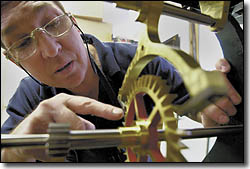At Busch Hall, Clock’s Time Has Come Again

The hands of time will begin turning again today on Busch Hall.
It has been more than four months since the circa 1930 tower clock was disassembled, removed, and then transported to Freeport, Maine, for much-needed cleaning, polishing, and restoration. This morning, the ornate 700-pound timepiece will be hauled back into the 1917 German-designed building that houses the Center for European Studies, taken by elevator to the fourth floor, then carried by hand up the 42 stairs that curl up inside the tower, where it will be reassembled and bolted back into place.
The clock is now in “museum-quality condition,” according to Philip Bisaga, the manager of mechanical and structural maintenance for the FAS Office of Physical Resources. It was Bisagas decision to proceed with the restoration, after following up on complaints that the clock wasnt keeping good time. When he inspected the mechanism up close, Bisaga saw the damage that 70 years of haphazard maintenance can cause. “People went up there who didnt know what they were doing, with the best intentions, and just starting putting oil on everything,” Bisaga says. “What happens is the grit thats in the air sticks to the oil, and then eventually becomes like sandpaper, so as the gears go around, it eventually starts cutting little grooves into the gears.” Those grooves can throw off the intricate device just enough to disrupt its ability to keep accurate time.
Bisaga turned to the Balzer Family Clock Works for help. The family-owned company, based in Freeport, Maine, has become one of the nations most renowned tower clock specialists. Company founder and owner Rick Balzer recommended a complete restoration. “The mechanism was failing,” he says. “It wouldnt have run much longer.” Last fall, the decision was made to go forth with the project. In late October, the clock was disassembled, its hands were removed, and all of the components were loaded up and taken to Balzers workshop.
Every gear, shaft, and pinion was cleaned and polished. The 3-foot tall, heavy, cast iron base was stripped, and then repainted its original colors cedar green, with black trim, orange pinstriping, and a gold-leaf floral design adorning each of the four corners. The 15-foot cherry wood pendulum was cleaned and lacquered. The pulleys were repainted. Each of the eight hands was balanced, and then brought back to life with shiny gold leaf. “Its a gorgeous instrument,” Balzer comments proudly as he assesses the finished product. “Its in the same shape as when it came out of the factory.”
The E. Howard Clock Company of Boston, where the clock was built, was considered one of the countrys preeminent clock makers in the late 1800s and early 1900s. Over the years, the company manufactured thousands of tower clocks, hundreds of which continue to operate today. The number two model, chosen by the architects of Busch Hall, is considered the “most sought-after,” according to Balzer. “It can run four 10-foot dials without batting an eye.” Resting on elegant sweeping legs, the clockworks are fully exposed, each gear turning against the next, ticking at a rate of 2,280 times an hour. Jutting out from the top of the mechanism are four 8-foot shafts, leading to dial gears in the outer walls, which turn the hands. Bisaga is fascinated by the “state-of-the-art” technology that went into the design. “Its a magnificent piece of engineering,” he says. “Its intricate and interesting to look at with everything right out there for you to see.”
Indeed, there are plans to open the clock room to visitors once the restored timepiece is back in place. The room has been cleaned and repainted, with new lighting added, and another electrical outlet installed to power the clocks new automatic winder. The winder was an added option that will spare Sandy Selesky, the building manager for the Center for European Studies, the chore of climbing the three flights of stairs up the tower every week. For the past 10 years, Selesky has been in charge of keeping the clock hands turning. “I have mixed emotions,” Selesky says. “Im glad that I wont have to worry about [the clock] as much, but part of me also feels sad I was always into gothic ghost stories, and the idea of walking up those 42 steps into a little tower with a hand-wound clock mechanism brought back memories of reading the old mystery books as a kid.” From now on, Selesky will only have to make that journey to the top of the tower every month or so, and only then to adjust the time.
Timing is everything in the clock business, and Balzer says the University should be proud of what its done. “They [University officials] were so receptive and interested and immediately acted upon getting this thing restored, and that was so refreshing.” The expert clock maker is now convinced the restored timepiece will outlive all of us. “If Harvard takes care of it, if it does its homework, and looks after this piece, it could last 600 years or more,” he says.




